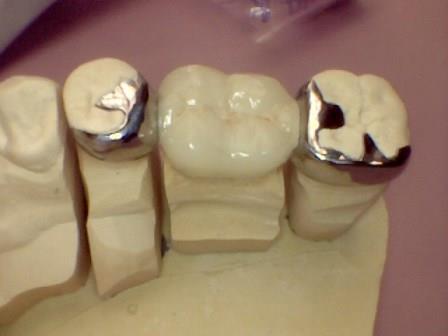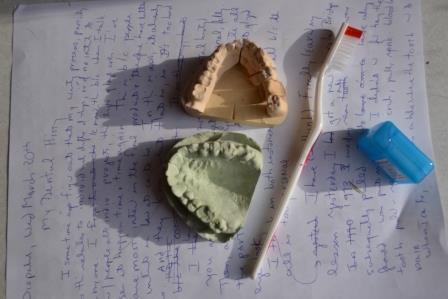
Home > Trip > Dispatches > Daily Dispatches 2013 > Daily Dispatch #79
March 20, 2013: My Dental History
I some time ago figured out that my writing process, particularly as this centers around individual drafts of poems and essays, is of little or no interest to anyone but me. I know this because when I talk with people about this, their eyes glaze over. I’ve seen this happen time and time again. This is because people are most interested in the final product and therefore have little interest in how the final product came to be. In their minds, it already is. And they now know what is, is. I once gave a paper at a conference in which I compared my writing process to my dental history. It works like this – You go the dentist. You walk out of the office with a new crown, root canal, or filling in place. If you’re lucky, you also walk out of the office with a new toothbrush and some floss. Then you go and tell someone about this, perhaps over lunch. In short order, their eyes glaze over. I have (I think) finally learned my lesson. Maybe so, or maybe not. Yesterday I went to the dentist, and forty minutes later, walked out with a new Maryland bridge in mouth, and toothbrush and floss in hand. Once again, a singular aspect of my overall dental history came back to mind. In July, 1972, one of my rear molars first turned black. I then developed an abscess. Our family dentist suggested that the tooth be pulled. I, who knew that I would not be able to handle it – crunch, yank, pull, blood -- asked to be put under, which was why he referred me to an oral surgeon. I came too and discovered that there was a hole where the old tooth used to be. Neither my family dentist nor the oral surgeon said anything about replacing the tooth. So I was left with a space where previously a molar used to be. In 1990, the rear tooth had tipped, and the bottom teeth had splayed considerably. I |
|
| was then living in Morris, Minnesota. I went to see a dentist who put in a Maryland Bridge. A Maryland Bridge (as defined) is a “retained bridge that’s a good treatment option for many missing teeth as it is relatively cheap when compared to alternatives such as dental implants, requires little or no damage to the surrounding teeth during preparation for placement, and is well tolerated by patients.” There’s also the cantilever bridge—two abutment crowns are placed side-by-side on the same side of the space created by the missing tooth. The pontic is then connected to the two crowns, which extend into the missing tooth space. My Minnesota dentist quite obviously determined that I was a good candidate for the Maryland bridge. Like other good candidates, I brush my teeth twice a day, floss regularly, and I don’t have tooth decay. I also didn’t smoke and had stable supporting teeth. In 2009 my Maryland Bridge came loose. I went to my current dentist, Dr. Mike, and he glued it back in place, saying that he wasn’t sure if it would stay put. He was right. It subsequently came loose several times. And he glued it back in place several times. Good man, Dr. Mike. Furthermore, the odds are that this sort of bridge will stay put. I put off suggesting that we act on an alternative because I presumed that the alternative would be to get an implant. This no more appealed to me than having a tooth pulled with local anesthetic. In fact, it appealed to me far less. It involves doing bone grafts and drilling into the transplanted bone grafts. I just didn’t want to be there, mentally or physically, for that. Something had to be done. That something was to get a new tooth. Dr. Mike wisely suggested that he put another Maryland bridge in place. After all, I’d done well with what I had – it was in my mouth for 28 years. I’d actually beaten the odds. (My later research findings indicated that the typical success rates are quoted as being as high as 80% after 15 years in the anterior maxilla. (That’s the upper jaw). Far lower success rates are seen in the posterior mandible. (That’s the lower jaw.) The process of putting in a New Maryland bridge took approximately 40 minutes. I do not know the full particulars of what Dr. Mike did, but I knew immediately that he’d done it well. I left his office feeling like this tooth would, like its predecessor, do its job well for another thirty years. Heck, it might outlast the rest of me. I strode forth with new tooth in mouth, and dental impression, floss, toothbrush, toothbrush holder in hand. After, Pete and I went out for dinner. I then had to stifle the urge to open my mouth and show the waitress my new tooth. It was hard not to. It’s actually a beautiful tooth. And the story of how my new tooth came to be is riveting. But no one is going to get wind of it. Just like no one is going to hear about the composing process history of this dispatch, that is one that required me to problem solve on several levels. For example, I had to go back in time and think some about my long past dental history. I also had to integrate research information into my findings. Also, I had to determine if I should or should not include information on the history of the Maryland bridge. And there was the words to images thing. I finally decided to include (here) a photo of my tooth, a photo of a Maryland bridge, and a combined dental photo/draft photo in which I pulled the whole thing together. I suspect that none of this is going to be of interest to anyone. So now moving on to other projects. |
|


